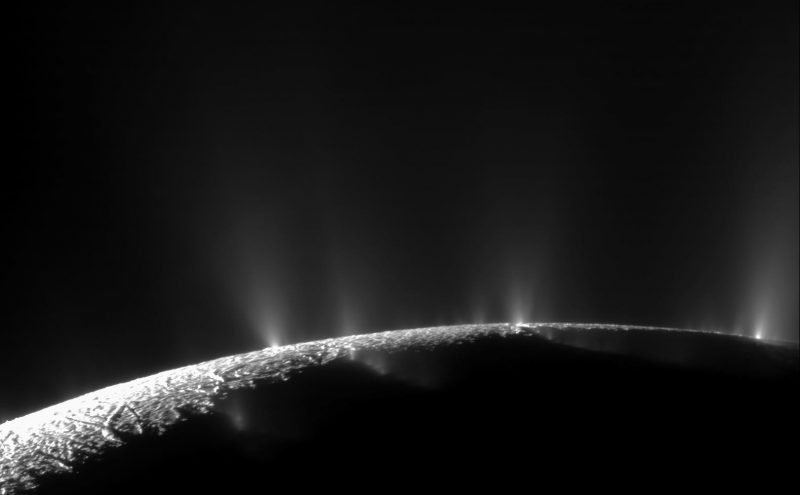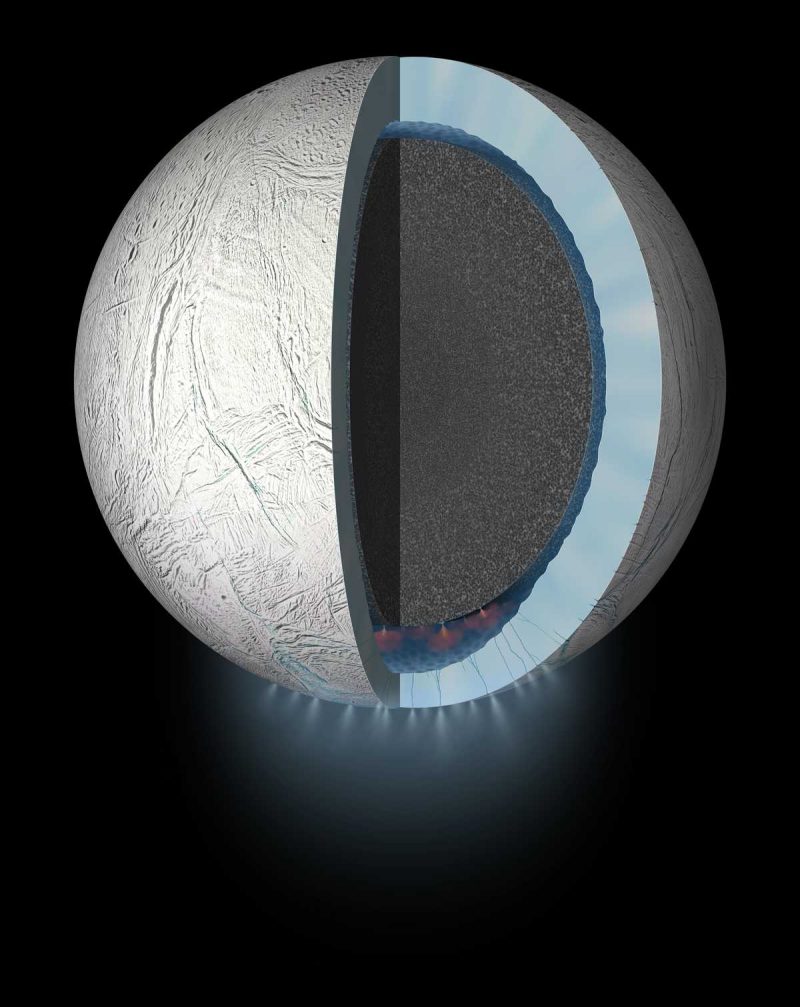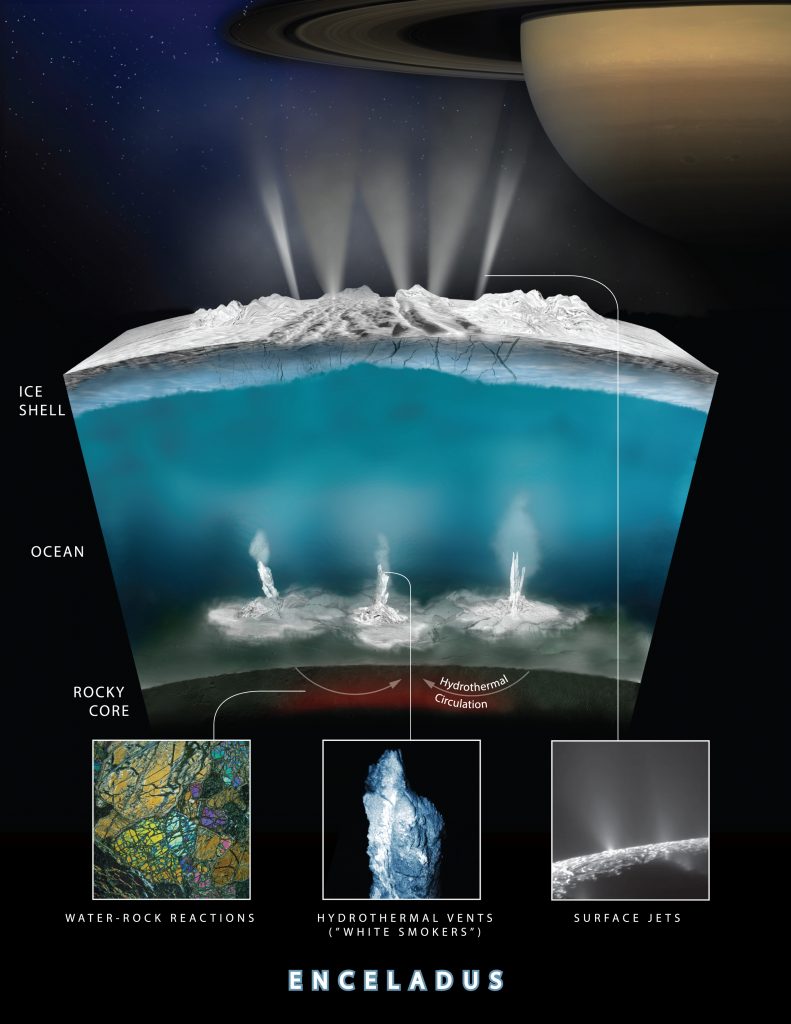

The geysers of Enceladus: huge plumes of water vapor erupting through cracks at the south pole of this moon of Saturn. The plumes contain water vapor, ice, salts, methane and both simple and complex organic molecules, the kind of molecules normally found in living systems. The geysers must come from somewhere. Scientists think there’s an ocean below Enceladus’ icy crust. Now a new study shows that the interior of Enceladus is more geochemically complex than once thought, boosting the prospects for life. Image via NASA’s Cassini spacecraft/ Space Science Institute.
The interior of Enceladus – the ocean moon of Saturn that might support life – is even more complex than previously thought, according to a new study from scientists at the Southwest Research Institute (SwRI). These researchers have developed a new geochemical model of the moon. It’s based on an analysis of material in the moon’s water vapor plumes. The analysis suggests that carbon dioxide is being controlled by chemical reactions on the seafloor of Enceladus’ interior ocean. The findings open up intriguing new possibilities for life in Enceladus’ subsurface watery abyss.
The new peer-reviewed results were published in the journal Geophysical Research Letters on January 22, 2020.
Lead author Christopher Glein of SwRI said in a statement:
By understanding the composition of the plume, we can learn about what the ocean is like, how it got to be this way and whether it provides environments where life as we know it could survive. We came up with a new technique for analyzing the plume composition to estimate the concentration of dissolved CO2 in the ocean. This enabled modeling to probe deeper interior processes.
From the new paper:
Enceladus, an ocean-harboring moon of Saturn, erupts a plume that contains gases and frozen sea spray into space. By understanding the composition of the plume, we can learn about what the ocean is like, how it got to be this way, and whether it provides environments where life as we know it could survive. This study presents a new perspective for analyzing the plume composition to estimate the concentration of dissolved carbon dioxide in the ocean. We find that the derived range based on two different data sets is intriguingly similar to what would be expected from the dissolution and formation of certain mixtures of silicon and carbon-bearing minerals at the seafloor. The deduced combination of minerals may be indicative of a fundamental process that has sequestered a large amount of Enceladus’ initial inventory of carbon dioxide into the rocky core. This inference echoes an emerging vision of a complex interior that hosts geochemically diverse environments. The dynamic interface of such complexity is where energy sources for possible life may arise.

View of Saturn’s moon Enceladus via the Cassini spacecraft. You can see the bluish tiger stripes on the moon’s left side. This image is tilted; the tiger stripes are at the moon’s south pole. Active geysers are erupting from the stripes even as we speak! Image via NASA/ ESA/ JPL/ SSI/ Cassini Imaging Team/ Carnegie Science.
The researchers were able to come to these conclusions based on continued analysis of spectrometry data sent back by NASA’s Cassini spacecraft. The Cassini mission ended in late 2017, and the last close flyby of Enceladus was on October 28, 2015. According to the analysis, the best way to explain the abundant amount of carbon dioxide below the moon’s surface is by geochemical reactions between the rocky core and the water in the ocean.
Cassini had also previously detected silica (SiO2) and molecular hydrogen (H2) in the ocean, by analyzing the composition of geyser-like plumes of water vapor erupting from the icy surface. This water originates in the ocean below, and makes its way to the surface through large cracks at the south pole, called tiger stripes, finally erupting into space as water vapor. According to Glein:
Based on our findings, Enceladus appears to demonstrate a massive carbon sequestration experiment. On Earth, climate scientists are exploring whether a similar process can be utilized to mitigate industrial emissions of CO2. Using two different data sets, we derived CO2 concentration ranges that are intriguingly similar to what would be expected from the dissolution and formation of certain mixtures of silicon- and carbon-bearing minerals at the seafloor.
Distinct sources of observed CO2, silica and H2 imply mineralogically and thermally diverse environments in a heterogeneous rocky core. We suggest that the core is composed of a carbonated upper layer and a serpentinized interior.

Diagram depicting the interior of Saturn’s moon Enceladus, with its rocky core, subsurface ocean and plumes of water vapor. Image via NASA/ JPL-Caltech/ SwRI.
But this evidence also points to even more complex activity, involving hydrothermal vents on the ocean floor. Cassini had previously found evidence for them, and now this new study adds to that. Both silica and molecular hydrogen are considered to be markers of hydrothermal activity.
Active hydrothermal vents would be an exciting discovery in an alien ocean such as the one on Enceladus. Why? They emit hot fluids rich in minerals and energy into the surrounding colder water. On Earth, they are central to ecosystems where a wide variety of life thrives. Could the same be true for Enceladus? According to Hunter Waite of SwRI and principal investigator of Cassini’s Ion Neutral Mass Spectrometer (INMS):
The dynamic interface of a complex core and seawater could potentially create energy sources that might support life. While we have not found evidence of the presence of microbial life in the ocean of Enceladus, the growing evidence for chemical disequilibrium offers a tantalizing hint that habitable conditions could exist beneath the moon’s icy crust.

The Cassini mission found evidence for hydrothermal activity – hydrothermal vents – on the bottom of Enceladus’ ocean. Could they help sustain life as they do on Earth? Image via NASA/ JPL-Caltech/ SwRI.
The scenario proposed by the researchers is that hydrothermal oxidation of reduced iron deep in the core creates H2, while hydrothermal activity intersecting quartz-bearing carbonated rocks produces silica-rich fluids. Such an environment could be quite habitable by earthly standards. Glein said:
The implications for possible life enabled by a heterogeneous core structure are intriguing. This model could explain how planetary differentiation and alteration processes create chemical (energy) gradients needed by subsurface life.
Cassini had previously found other tantalizing hints about the conditions in Enceladus’ ocean. When the spacecraft analyzed the water vapor from the plumes – that it flew through directly – it found water vapor, ice particles, salts, methane, and a variety of simple and complex organic molecules.
Another recent study by scientists at the Carnegie Institute for Science has also helped explain how the tiger stripes formed, and how they remain active, due to deformation of the ice crust by Saturn’s powerful gravitational pull. Another study from last summer found that Enceladus’ ocean is just the right age to support life.

Christopher Glein, lead author of the new study. Image via NASA Astrobiology Institute.
All of these discoveries, and now this new study, are painting a picture of Enceladus as a potentially quite habitable world. But further research and return missions – now on the drawing boards – will be needed to finally answer the question of whether that deep, dark ocean is actually inhabited by any kind of alien lifeforms.
The newest findings don’t prove that there is life on, or rather in, Enceladus, but they do add to the growing evidence that the subsurface ocean is probably quite habitable. Along with Jupiter’s moon Europa, and possibly another moon of Saturn, Titan, Enceladus is looking more and more like one of the best places in the solar system to look for life beyond Earth.
Bottom line: A new study from Southwest Research Institute shows that the interior of Saturn’s ocean moon Enceladus is more geochemically complex that previously thought, making the ocean quite habitable for possible life.
Source: The carbonate geochemistry of Enceladus’ ocean
from EarthSky https://ift.tt/2U87N2q


The geysers of Enceladus: huge plumes of water vapor erupting through cracks at the south pole of this moon of Saturn. The plumes contain water vapor, ice, salts, methane and both simple and complex organic molecules, the kind of molecules normally found in living systems. The geysers must come from somewhere. Scientists think there’s an ocean below Enceladus’ icy crust. Now a new study shows that the interior of Enceladus is more geochemically complex than once thought, boosting the prospects for life. Image via NASA’s Cassini spacecraft/ Space Science Institute.
The interior of Enceladus – the ocean moon of Saturn that might support life – is even more complex than previously thought, according to a new study from scientists at the Southwest Research Institute (SwRI). These researchers have developed a new geochemical model of the moon. It’s based on an analysis of material in the moon’s water vapor plumes. The analysis suggests that carbon dioxide is being controlled by chemical reactions on the seafloor of Enceladus’ interior ocean. The findings open up intriguing new possibilities for life in Enceladus’ subsurface watery abyss.
The new peer-reviewed results were published in the journal Geophysical Research Letters on January 22, 2020.
Lead author Christopher Glein of SwRI said in a statement:
By understanding the composition of the plume, we can learn about what the ocean is like, how it got to be this way and whether it provides environments where life as we know it could survive. We came up with a new technique for analyzing the plume composition to estimate the concentration of dissolved CO2 in the ocean. This enabled modeling to probe deeper interior processes.
From the new paper:
Enceladus, an ocean-harboring moon of Saturn, erupts a plume that contains gases and frozen sea spray into space. By understanding the composition of the plume, we can learn about what the ocean is like, how it got to be this way, and whether it provides environments where life as we know it could survive. This study presents a new perspective for analyzing the plume composition to estimate the concentration of dissolved carbon dioxide in the ocean. We find that the derived range based on two different data sets is intriguingly similar to what would be expected from the dissolution and formation of certain mixtures of silicon and carbon-bearing minerals at the seafloor. The deduced combination of minerals may be indicative of a fundamental process that has sequestered a large amount of Enceladus’ initial inventory of carbon dioxide into the rocky core. This inference echoes an emerging vision of a complex interior that hosts geochemically diverse environments. The dynamic interface of such complexity is where energy sources for possible life may arise.

View of Saturn’s moon Enceladus via the Cassini spacecraft. You can see the bluish tiger stripes on the moon’s left side. This image is tilted; the tiger stripes are at the moon’s south pole. Active geysers are erupting from the stripes even as we speak! Image via NASA/ ESA/ JPL/ SSI/ Cassini Imaging Team/ Carnegie Science.
The researchers were able to come to these conclusions based on continued analysis of spectrometry data sent back by NASA’s Cassini spacecraft. The Cassini mission ended in late 2017, and the last close flyby of Enceladus was on October 28, 2015. According to the analysis, the best way to explain the abundant amount of carbon dioxide below the moon’s surface is by geochemical reactions between the rocky core and the water in the ocean.
Cassini had also previously detected silica (SiO2) and molecular hydrogen (H2) in the ocean, by analyzing the composition of geyser-like plumes of water vapor erupting from the icy surface. This water originates in the ocean below, and makes its way to the surface through large cracks at the south pole, called tiger stripes, finally erupting into space as water vapor. According to Glein:
Based on our findings, Enceladus appears to demonstrate a massive carbon sequestration experiment. On Earth, climate scientists are exploring whether a similar process can be utilized to mitigate industrial emissions of CO2. Using two different data sets, we derived CO2 concentration ranges that are intriguingly similar to what would be expected from the dissolution and formation of certain mixtures of silicon- and carbon-bearing minerals at the seafloor.
Distinct sources of observed CO2, silica and H2 imply mineralogically and thermally diverse environments in a heterogeneous rocky core. We suggest that the core is composed of a carbonated upper layer and a serpentinized interior.

Diagram depicting the interior of Saturn’s moon Enceladus, with its rocky core, subsurface ocean and plumes of water vapor. Image via NASA/ JPL-Caltech/ SwRI.
But this evidence also points to even more complex activity, involving hydrothermal vents on the ocean floor. Cassini had previously found evidence for them, and now this new study adds to that. Both silica and molecular hydrogen are considered to be markers of hydrothermal activity.
Active hydrothermal vents would be an exciting discovery in an alien ocean such as the one on Enceladus. Why? They emit hot fluids rich in minerals and energy into the surrounding colder water. On Earth, they are central to ecosystems where a wide variety of life thrives. Could the same be true for Enceladus? According to Hunter Waite of SwRI and principal investigator of Cassini’s Ion Neutral Mass Spectrometer (INMS):
The dynamic interface of a complex core and seawater could potentially create energy sources that might support life. While we have not found evidence of the presence of microbial life in the ocean of Enceladus, the growing evidence for chemical disequilibrium offers a tantalizing hint that habitable conditions could exist beneath the moon’s icy crust.

The Cassini mission found evidence for hydrothermal activity – hydrothermal vents – on the bottom of Enceladus’ ocean. Could they help sustain life as they do on Earth? Image via NASA/ JPL-Caltech/ SwRI.
The scenario proposed by the researchers is that hydrothermal oxidation of reduced iron deep in the core creates H2, while hydrothermal activity intersecting quartz-bearing carbonated rocks produces silica-rich fluids. Such an environment could be quite habitable by earthly standards. Glein said:
The implications for possible life enabled by a heterogeneous core structure are intriguing. This model could explain how planetary differentiation and alteration processes create chemical (energy) gradients needed by subsurface life.
Cassini had previously found other tantalizing hints about the conditions in Enceladus’ ocean. When the spacecraft analyzed the water vapor from the plumes – that it flew through directly – it found water vapor, ice particles, salts, methane, and a variety of simple and complex organic molecules.
Another recent study by scientists at the Carnegie Institute for Science has also helped explain how the tiger stripes formed, and how they remain active, due to deformation of the ice crust by Saturn’s powerful gravitational pull. Another study from last summer found that Enceladus’ ocean is just the right age to support life.

Christopher Glein, lead author of the new study. Image via NASA Astrobiology Institute.
All of these discoveries, and now this new study, are painting a picture of Enceladus as a potentially quite habitable world. But further research and return missions – now on the drawing boards – will be needed to finally answer the question of whether that deep, dark ocean is actually inhabited by any kind of alien lifeforms.
The newest findings don’t prove that there is life on, or rather in, Enceladus, but they do add to the growing evidence that the subsurface ocean is probably quite habitable. Along with Jupiter’s moon Europa, and possibly another moon of Saturn, Titan, Enceladus is looking more and more like one of the best places in the solar system to look for life beyond Earth.
Bottom line: A new study from Southwest Research Institute shows that the interior of Saturn’s ocean moon Enceladus is more geochemically complex that previously thought, making the ocean quite habitable for possible life.
Source: The carbonate geochemistry of Enceladus’ ocean
from EarthSky https://ift.tt/2U87N2q

Aucun commentaire:
Enregistrer un commentaire